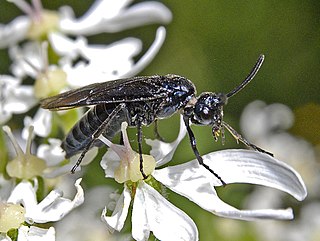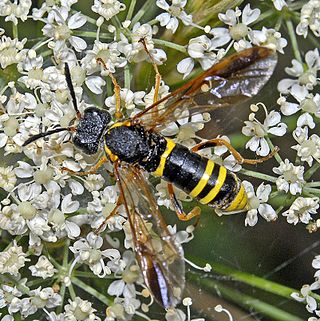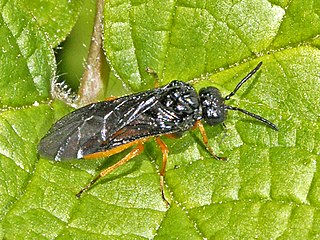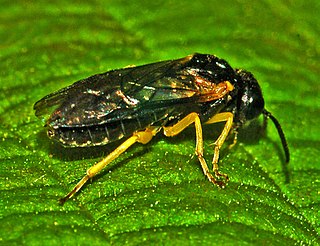
Sawflies are the insects of the suborder Symphyta within the order Hymenoptera, alongside ants, bees, and wasps. The common name comes from the saw-like appearance of the ovipositor, which the females use to cut into the plants where they lay their eggs. The name is associated especially with the Tenthredinoidea, by far the largest superfamily in the suborder, with about 7,000 known species; in the entire suborder, there are 8,000 described species in more than 800 genera. Symphyta is paraphyletic, consisting of several basal groups within the order Hymenoptera, each one rooted inside the previous group, ending with the Apocrita which are not sawflies.

Arge pagana is a sawfly in the family Argidae. It is known by the name "large rose sawfly" although the related species Arge ochropus is also known by this name.

Arge cyanocrocea, the bramble sawfly, is a species of sawflies of the family Argidae, subfamily Arginae.

Arge ochropus, the rose sawfly, is a species belonging to the family Argidae subfamily Arginae.

The turnip sawfly is a typical sawfly with dark green or blackish 18–25 mm long larvae that feed on plants of the brassica family, and can sometimes be a pest. It winters below the ground, emerging in early summer as a 7–8 mm adult with a mainly orange body and a black head. The adult feeds on nectar.

Cimbex femoratus, the birch sawfly, is a species of sawfly in the family Cimbicidae.

Abia sericea, common name club horned sawfly or scabious sawfly, is a species of sawflies belonging to the family Cimbicidae.

Arge berberidis, common name berberis sawfly, is a species of sawflies belonging to the family Argidae subfamily Arginae.

Tenthredo vespa is a sawfly species belonging to the family Tenthredinidae.

Tenthredo moniliata is a sawfly species belonging to the family Tenthredinidae.

Nematus spiraeae is a species of sawfly in the family Tenthredinidae, known as the aruncus sawfly and sometimes the spiraea sawfly. It is native to central and northern Europe and was first recorded in Britain in 1924. Its larvae feed on the leaves of goat's beard.

Nematus oligospilus, commonly known as the willow sawfly, is a species of sawfly in the family Tenthredinidae. Native to central and northern Europe and Asia, it was first recorded in South America in the 1980s and New Zealand in 1997, and has also been introduced to Australia, South Africa and Lesotho. Its larvae feed on the leaves of various species of willow.

Diprion similis is a species of sawfly in the family Diprionidae. It is native to central and northern Europe and Asia but was accidentally introduced into North America where it has become invasive. The larvae feed on the needles of pine trees, especially those of the white pine. In North America it is known as the introduced pine sawfly or the imported pine sawfly. It is also known as the white pine sawfly because of its preference for feeding on the white pine, but this name is confusing because another sawfly, Neodiprion pinetum, whose larvae also feed on this tree, is itself known as the "white pine sawfly".

Neodiprion lecontei is a species of sawfly in the family Diprionidae native to eastern North America, commonly known as the red-headed pine sawfly or Leconte's sawfly. The larvae feed on the foliage of many species of native and imported pines. This species was named after John Lawrence LeConte, an American entomologist of the 19th century.

Megalodontes cephalotes is a species of sawflies within the Symphyta belonging to the family Megalodontesidae.

Tenthredo crassa is a sawfly species belonging to the family Tenthredinidae.

Tenthredo amoena is a sawfly species belonging to the family Tenthredinidae.

Eutomostethus luteiventris is a species of sawflies belonging to the family Tenthredinidae, subfamily Blennocampinae.

Aneugmenus padi is a species of sawfly.

Eriocampa ovata, known generally as the alder sawfly or woolly alder sawfly, is a species of common sawfly in the family Tenthredinidae. The larvae feed on the leaves of the common alder and the grey alder, sometimes causing defoliation.




















